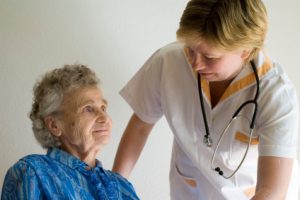 As individuals age, the manner in which their skin repairs itself also changes. In fetuses, healing is scar-free and skin is highly regenerative. However, the skin of the elderly may degenerate on its own and sometimes even without the presence of an injury. Additionally, the limited regenerative ability that is found in the skin of the elderly can impair the healing process of their wounds, and may sometimes lead to chronic wounds that do not heal. As a result, elderly wound care represents an important facet of elderly medical care.
As individuals age, the manner in which their skin repairs itself also changes. In fetuses, healing is scar-free and skin is highly regenerative. However, the skin of the elderly may degenerate on its own and sometimes even without the presence of an injury. Additionally, the limited regenerative ability that is found in the skin of the elderly can impair the healing process of their wounds, and may sometimes lead to chronic wounds that do not heal. As a result, elderly wound care represents an important facet of elderly medical care.
Elderly Wound Care
Elderly wound care is a significant and important part of the duties often assigned to nursing home staff. Diabetes and other illnesses can compromise the strength of elderly individual’s skin. This can result in a greater susceptibility to sustaining a wound. As a result of older skin’s slower rate of healing, elderly wound care is often considered in a context of treating chronic wounds and making sure that they do not getting any worse. Instead of aiming for complete eradication of a chronic wound, a health professional may opt for an approach that focuses on managing a chronic wound and keeping overall damage to a minimum.
Healing Chronic Wounds
A chronic wound is a wound which heals very slowly, not at all, or is recurrent in nature. There are a number of types of chronic wounds. Many of these occur in older individuals, and many require elderly wound care in a nursing home setting. In addition to the inherent degeneration caused by aging, there are a number of factors which can complicate elderly wound care and slow or disrupt the healing process.
Elderly wound care difficulties may be caused by:
– Infection: An open wound can develop a bacterial infection. If a wound becomes infected, the body will focus on fighting the infection instead of healing the wound.
– Dead Skin: Also known as necrosis, dead skin around a wound may interfere with the body’s ability to heal itself and close the wound.
– Bleeding: If a wound bleeds on a regular basis, the bleeding may obstruct the body’s ability to close the edges of the wound.
– Poor Diet: If an elderly individual is not receiving essential nutrients like protein, vitamin C and zinc, elderly wound care will be made more difficult. Wounds will be slow to heal or may worsen.
– Immobility: Elderly wound care is complicated when a patient is unable to move. Constant friction and pressure can worsen a wound’s severity and also cause issues such as ulcers and bedsores. Elderly wound care often focuses on injuries sustained due to bedsores or ulcers.
– Excessive Dryness/Wetness: In order to maximize the results of elderly wound care, it is important that wounds are neither too dry nor too wet. Elderly wound care requires that dressings and bandages are frequently monitored so that a wound remains at an appropriate level of moistness.
Improper Elderly Wound Care
Bedsores, ulcers and other types of wounds require frequent treatment and attention. This is a major responsibility for licensed nursing home staff. However, there are instances when improper elderly wound care can result in further health complications or even premature death.
In cases where a nursing home’s staff may be responsible for injuring a loved one or causing their death, it may be appropriate to file a lawsuit. The decision of whether or not to file a lawsuit is best made with the help of a qualified medical malpractice attorney. Lawsuits against nursing homes often focus on the complications which arise from negligence by staff. Elderly wound care is an area of nursing home treatment where there is a significant amount of room for potential negligence.
Sources:
Gist, S., I. Tio-Matos, S. Falzgraf, and S. Cameron. “Wound care in the geriatric client.” NCBI. n. page. Web. 21 May. 2013. http://www.ncbi.nlm.nih.gov/pmc/articles/PMC2697592/
Takahashi, Paul, and Lester Kiemele. “Wound Care for Elderly Patients: Advances and Clinical Applications for Practicing Physicians.” Mayo Clinic Proceedings. 79.2 (2004): 260-267. Web. 21 May. 2013. http://www.mayoclinicproceedings.org/article/S0025-6196(11)63177-7/abstract
